Everett Raymond Kinstler: Reminiscing at His National Arts Club Studio

by Louise B. Hafesh
Sitting comfortably in the antechamber of Everett Raymond Kinstler’s Gramercy Park studio in Manhattan, I felt an overwhelming sense of the significance of the place and its current inhabitant’s contribution to the art world.
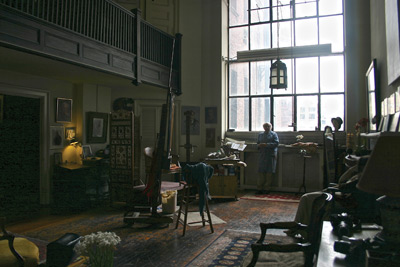
After all, we were in not only an historic New York City landmark, the National Arts Club, but also the former studio of the American Impressionist and prominent teacher Frank Vincent DuMond (1865–1951). What’s more, this is the studio where Kinstler had painted what amounts to a pictorial who’s who of over 2,000 portraits, including those of Tony Bennett, Katharine Hepburn, Tom Wolfe, countless business leaders, more than 50 U.S. Cabinet members and seven U.S. presidents. Like a kid in a candy store, I scoured the place, taking everything in.
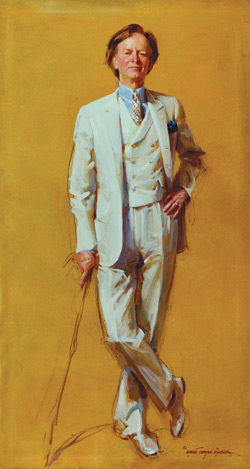
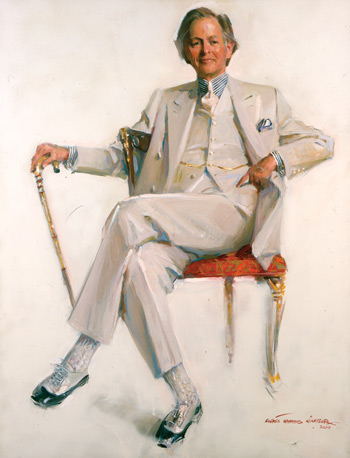
Not a day goes by,” says Kinstler, “that I don’t think of Mr. Dumond, who was my teacher at the Art Students League.” It was at that school that Kinstler himself would later teach full time from 1969 to 1974 and give weekend workshops through 2010. “I loved the old man,” continues Kinstler. “He used to call me his ‘boy’ and, taking me under his wing, helped secure my first studio at the National Arts Club. After his death, I moved into his larger space.”
And what a space it is! Bright and airy (20×30 feet) with an 18-foot ceiling, one entire wall of north-lit windows plus a grand balcony that stretches across another wall. Paintings, sketches and photographs lie scattered about, along with an eclectic assortment of props and resources, including an impressive private library and a life-sized seated mannequin affectionately known as Ms. Draper (bequeathed to the studio by portraitist William F. Draper, 1912–2003). To the right of Kinstler’s easel (originally owned by another mentor and friend, the illustrator James Montgomery Flagg, 1877–1960), a simple chair rests on a worn platform, while a hand-carved wooden screen is flanked on the right by a taboret on which rests John Singer Sargent’s actual palette. “That was a gift bequeathed to me from the New Jersey painter Paul Burns (1910–1990),” says Kinstler. “It had been part of Sargent’s estate sale in 1925.”
Having already discovered that every nook and cranny holds some treasure and an opportunity for a personal anecdote, I try to appear nonchalant about this last revelation. I comment on a small, striking painting of Katharine Hepburn (whom Kinstler had painted more than 40 times in the 1980s and 1990s).
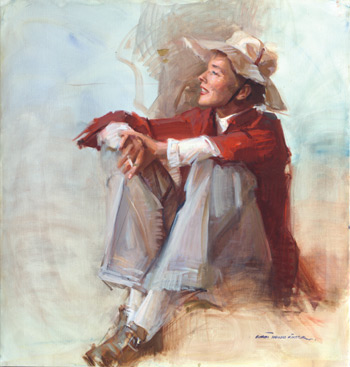
Kinstler confided that, at her sittings, the actress had insisted on overseeing every detail, dictating incessant instructions, often to Kinstler’s exasperation. “I finally said to her, ‘Ms. Hepburn, I admire you so much, but your constant critiques are driving me crazy,” recalls Kinstler. “She thought for a second and then said, ‘You know what your problem is? You talk too much!’” When that particular portrait was complete, Hepburn declared (to Kinstler’s surprise) that it was her favorite and told the artist, “I like you—you do your homework.”
>>Free Download: Learn How to Draw People<<
Kinstler’s Rise From Pulps to Portraits
My visit with Kinstler took place a week after the opening of “Pulps to Portraits,” the artist’s 2012 exhibition at the Norman Rockwell Museum in Stockbridge, Massachusetts, a retrospective that explored how illustration had shaped the artist’s work and influenced his transition into portraiture. Still riding high from that celebration, he and I discussed his reaction to seeing his life’s work showcased in a significant place and in such a comprehensive way.

“I feel a little like a Dickens character who’s transported by the ghosts of past and present and gets to view everything from a different perspective,” Kinstler said with a laugh. “It’s odd but quite rewarding to look back on a career that spans more than 70 years and see the progression of the work.”
Time travel aside, it’s been quite a ride for the Manhattan-born artist who left school at age 16 to take a job drawing comic books, magazine illustrations and paperback book covers. His magazine and comic contributions, including the first Zorro comics and illustrations for the pulp magazine, The Shadow, are often credited with influencing the Pop art school—a point reinforced by Roy Lichtenstein, who once told the artist, “You were Pop art before it even existed.”
As an inker’s apprentice in the 1950s, Kinstler completed 180 comic strip panels each week. He credits this early work with helping him attract freelance pulp book and magazine assignments as well as honing his ability to tell a story visually, a skill he put to good use in his portraits. “
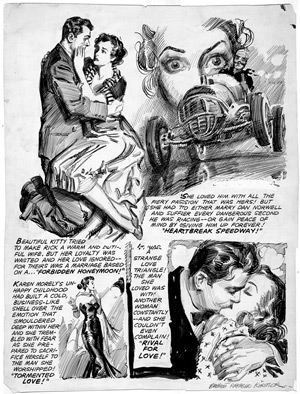
When I began illustrating, I wasn’t aware that the field was disappearing,” he says. “Culture was changing, photography was taking over, television was coming in and magazines were folding. And with the market and business starting to decline, I had to think differently.”
Kinstler as a Painter of People
Out of necessity, the young illustrator began to look for more viable outlets for his art. “Painting people was always what I enjoyed most,” Kinstler explains, “so making the transition into portraiture was a natural shift.” Suffice to say, portraiture was also something he was exceptionally gifted at. Signing on with Portraits, Inc., a gallery that specializes in securing portrait commissions, he soon established himself as one of America’s top portrait painters.

“It’s been stimulating to paint people,” he says. “I’m a storyteller; that’s my journey. What I value most are imagination, feeling and the skill to communicate—those qualities have always been the measure for me,” says Kinstler, who ranks capturing a person’s essential character above all else. “Painting a convincing portrait is not always about getting a likeness,” he says. “Naturally, that helps, but often it’s about getting a point of view.” To that end, he recommends doing advance life studies, pointing out that spending time with the subject to get a sense of what he or she is like, looking for significant characteristics and being selective about certain traits—along with sincerity and passion for what you’re doing—are integral to the process.
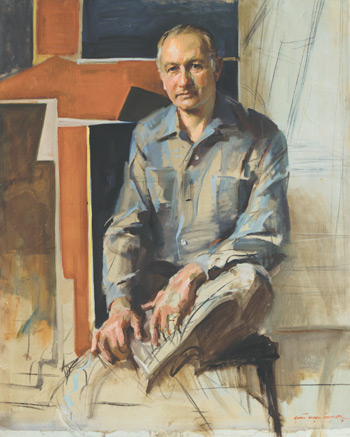
Anatomy of a Portrait by Kinstler
Generally Kinstler works from life, although he does take photographs for secondary reference. He begins on a bluish-gray toned canvas and, once his model is posed to conform to preliminary sketches, places a few rough indicators for composition before delving directly into painting alla prima.
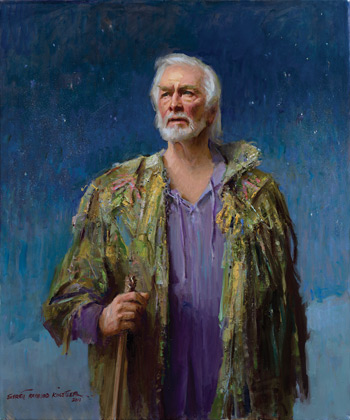
“I feel a responsibility to capture both the spirit and likeness of the people I paint, and so I prefer my sitters to be animated rather than motionless,” he says. “Carrying on a lively conversation as I work helps. In so doing, I also get to see other facets of my subject that I can perhaps incorporate into the portrait.”
Concluding our visit, Kinstler remarked: “I was recently asked an intriguing question: ‘If you could paint anyone in the world, who would that be?’ Almost immediately,” says Kinstler, “names like Sir Laurence Olivier and Winston Churchill came to mind—mostly people who were or are larger than life. After further thought, though, I realized my subjects are not just well-known personalities, but rather people from all walks of life. And since everyone in his or her own way has a story and what I most enjoy about the process is capturing the essence of a person’s character, you could say that I’m already painting the very people whose essences I most want to interpret!”
Artist and writer Louise B. Hafesh is a contributing editor for The Artist’s Magazine. Visit her website at www.louisebhafesh.com and her blog at www.paintersportal.blogspot.com.
LEARN MORE
- Listen to an hour-long Q&A session with Raymond Everett Kinstler and view the accompanying Powerpoint presentation.
- Read Raymond Everett Kinstler’s Web article on painting plein air landscapes.
- Learn to piant life-like portraits with Chris Saper’s book Classical Oil Painting in Oils.
- See David Jon Kassan’s oil portrait demonstration (Web article)
- Start Drawing: Drawing Basics for the Beginning Artist (Free Download)
- Order Art of Portrait Drawing eBook by Joy Thomas.
MORE RESOURCES FOR ARTISTS





Have a technical question?
Contact UsJoin the Conversation!